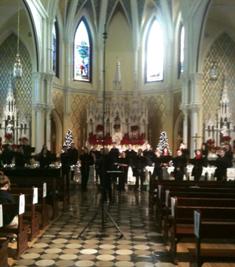
|
Nally kept his word Sunday in Summit Country Day School Chapel in Hyde Park. Always a beauty, this VAE Christmas concert was that and more. Call it a musical essay, a gift of time, whatever, Nally made the listener feel immersed in the music – in another world almost. And no one does it better than the 24-voice VAE. There were no thoughts of shopping, decorating, baking or any of the multitudinous tasks of the holiday season.
The concert (and Saturday’s opener at St. Boniface Church in Northside) was called “A Candlelit Christmas,” and so it was, with the Gothic-style Chapel handsomely decorated with red poinsettias, white mini-lights and candles. As the sun set and the light from the stained glass windows faded, the encompassing warmth of the Chapel heightened the feeling of being suspended in time. There was no intermission and no applause until the end. The singers played hand bells to provide continuity between numbers, create atmosphere and set pitches.
The choir entered from the rear of the Chapel with “O Come Emmanuel” and a gentle Norwegian lullaby, “Sov, Sov Liten Gut” (“Sleep. Sleep Little Boy”). Positioning themselves across the front of the chancel, they sang Gabriel Jackson’s joyous, full-voiced “To Morning” (2007). This was followed by John Joubert’s exquisite, 1954 setting of “There is No Rose of Such Virtue,” which began ever so softly on the interval of a third by a pair of women’s voices. This medieval text was heard three times during the concert, with versions attributed to John Dunstable (ca. 1420) and the 1996 setting by Stephen Caracciolo.
Presenting traditional carols in less familiar settings was a thread on the program. “Lo, How a Rose,” “ What Child is This” and “Silent Night” also were heard in contemporary treatments.
The first set also included Paul Manz’s touching “E’en So Lord Jesus Quickly Come” (1953), Caracciolo’s joyous “People Look East” and Alfred Burt’s “The Star Carol” (1954), during which the singers filed down the side aisles. All stood for the proposition -- as did the entire concert – that a carol need not be a familiar one to evoke the Christmas spirit. (It is the overall mission of Nally and the VAE to focus on music of our time.)
The second set began with “Bia, Bia Lite Ban” (“Hush, Hush Little Child”), another tender Norwegian lullaby. Steve Martland’s cheerful, 1997 “Make We Joy” was followed by a big, dissonant hand bell “chord (commentary?), then the ineffable “Lo, How a Rose Ere Blooming” in the 1933 version by Hugo Distler. The choir processed to the left transept of the Chapel for Nally’s own “Christ Child’s Lullabye.” This lovely carol began with soprano solo and alternated contemporary harmonization with more polyphonic treatment. Following was William Chatterton Dix’s “What Child Is This?” in the 1971 arrangement by B. Brant Ruggles.
Composer Karl Hirten’s lovely “Child of Sweetness” (1992) saw the choir move through the pews to the right transept. There they sang Sir David Willcocks’ spellbinding arrangement of the Basque carol “Gabriel’s Message” and Gustav Holst’s serenely beautiful “”Lullay My Liking” (1916).
The singers were back in the chancel for “Silent Night” in the splendid 1992 arrangement by former Cincinnatian J. David Moore (founder of the Village Waytes). Clothed in new harmonies, the old favorite sounded re-vivified and as such, segued beautifully into a repeat of the lullaby “Bia Bia Lite Ban” and the final set, beginning with Edwin Fissinger’s “Love Came Down at Christmas” (1979). Herbert Howells’ 1918 “A Spotless Rose” (a setting of “Lo, How a Rose”) demonstrated yet again how a new treatment can transform a familiar one.
“The Infant King,” a lovely Basque carol arranged by Willcocks, ornamented with hand bells, brought the final set to a close. The recessional, “O Come Emmanuel,” followed, but with a surprise. It was as if the outside world with all its noise and confusion had suddenly broken in. After a unison “rejoice,” the singers rapidly took their leave by the outside aisles, each singing out of sync with the others to create a chaotic din.
To ease the transition to the cold outside, there were snacks and drinks in the vestibule.